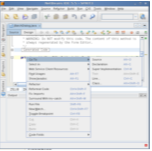Java
Introduction
Java(tm) is an Object Oriented platform independent programming language originally from Sun. It was designed to be a "simple, object-orientated, distributed, interpreted, robust, secure, architecture neutral, portable, high-performance, multithreaded, and dynamic language".
The suite of java utilities usually includes javac (Java Compiler,
for writing programs) and java (Java Interpreter, for running
programs). On the teaching system we currently have at least java 1.5. We also have the
NetBeans IDE (Integrated Development Environment). Releases include
On the teaching system we currently have at least java 1.5. We also have the
NetBeans IDE (Integrated Development Environment). Releases include
- Java SE - The Standard Edition (also known as Java 2 Platform)
- Java EE - The Enterprise Edition provides web services, component model, management, and communications APIs for service-oriented architecture (SOA) and Web 2.0 applications.
- Java ME - The Micro Edition for applications running on mobile phones, PDAs, TV set-top boxes, and printers
We have the Standard Edition.
Learning Java
Three local talks (in order of difficulty) are
The locally installed Introduction to Programming Using Java by David J. Eck teaches Java as well as general programming. Also locally we have
- More Examples (for those who like to learn by example, or want to see what Java can do)
- Issues related to CUED's C++ courses (for those confident enough about C++ to use it as a basis for learning Java)
- Issues related to CUED's IIA Computing course (for those taking course 3F6 )
- java.sun.com's "New to Java Programming Center" (the Learning Paths page offers a range of approaches)
- Unraveling Java Terminology
- Java courses at Rice University, State University of New York and Hobart and William Smith Colleges
- the Computing Service's Java information
- Java Forums
- Java FAQ archives
More advanced users might be interested in Dynamic Class Loading in Java
On the Teaching System you can run a Java demo by typing
java -jar /usr/java/jdk1.6.0/demo/jfc/Java2D/Java2Demo.jar
Java and the WWW
Java code can be loaded and executed by WWW browsers. Here's an example of the use of an APPLET tag.
<applet codebase="http://java.sun.com/applets/applets/NervousText"
code="NervousText.class" width="400" height="75" align="center" >
<param name="text" value="This is the Applet Viewer.">
<blockquote>
<hr>
If you were using a Java-enabled browser,
you would see dancing text instead of this paragraph.
<hr>
</blockquote>
</applet>
Amongst sample code available is Applet Code Samples
Further Information
- Java.sun.com
- Some local notes are online.
